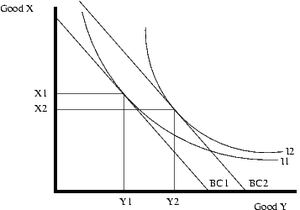- Inferior good
-
In consumer theory, an inferior good is a good that decreases in demand when consumer income rises, unlike normal goods, for which the opposite is observed.[1] Normal goods are those for which consumers' demand increases when their income increases. [2] Inferiority, in this sense, is an observable fact relating to affordability rather than a statement about the quality of the good. As a rule, these goods are affordable and adequately fulfil their purpose, but as more costly substitutes that offer more pleasure (or at least variety) become available, the use of the inferior goods diminishes.
Depending on consumer or market indifference curves, the amount of a good bought can either increase, decrease, or stay the same when income increases.
Examples
Cheaper cars are examples of the inferior goods. Consumers will generally prefer cheaper cars when their income is constricted. As a consumer's income increases the demand of the cheap cars will decrease, while demand of costly cars will increase, so cheap cars are inferior goods. Inter-city bus service is also an example of an inferior good. This form of transportation is cheaper than air or rail travel, but is more time-consuming. When money is constricted, travelling by bus becomes more acceptable, but when money is more abundant than time, more rapid transport is preferred.
Inexpensive foods like bologna, hamburger, mass-market beer, frozen dinners, and canned goods are additional examples of inferior goods. As incomes rise, one tends to purchase more expensive, appealing and nutritious foods[citation needed]. Likewise, goods and services used by poor people for which richer people have alternatives exemplify inferior goods. As a rule, used and obsolete goods (but not antiques) marketed to persons of low income as closeouts are inferior goods at the time even if they had earlier been normal goods or even luxury goods.
Others are very inconsistent across geographic regions or cultures. The potato, for example, generally conforms to the demand function of an inferior good in the Andean region where the crop originated. People of higher incomes and/or those who have migrated to coastal areas are more likely to prefer other staples such as rice or wheat products as they can afford them. However, in several countries of Asia, such as Bangladesh, potato is not an inferior good, but rather a relatively expensive source of calories and a high-prestige food, especially when eaten in the form of "French fries" by urban elites.[3]
Some inferior goods are so consistent that they can be seen as economic indicators. One such is instant noodles, where an early 2005 increase in the Thai "Mama Noodles Index" (the number of the popular Mama-brand instant noodles sold in that country) was seen as a sign of weakness after about ten years of stability.
Recently, there has been some interest in cataloging and identifying inferior goods in the United States. One such project, developed by economist.com, seeks to document characteristics that would identify goods as inferior. In 1997, several Michigan scholars from Western Michigan University identified many commonplace grocery store goods as inferior. Some of the goods identified as inferior goods are:
Giffen goods
Main article: Giffen goodA special type of inferior good may exist known as the Giffen good, which would disobey the "law of demand". Quite simply, when the price of a Giffen Good increases, the demand for that good increases. This would have to be a good that is such a large proportion of a person or market's consumption that the income effect of a price increase would produce, effectively, more demand. The observed demand curve would slope upward, indicating positive elasticity.
References
- ^ "Economics A-Z", the Economist, http://www.economist.com/research/Economics/alphabetic.cfm?term=Inferior_goods#inferiorgoods
- ^ Sullivan, arthur; Steven M. Sheffrin (2003), Economics: Principles in action, Upper Saddle River, New Jersey 07458: Pearson Prentice Hall, pp. 87, ISBN 0-13-063085-3, http://www.pearsonschool.com/index.cfm?locator=PSZ3R9&PMDbSiteId=2781&PMDbSolutionId=6724&PMDbCategoryId=&PMDbProgramId=12881&level=4
- ^ Scott, G.J.; Bouis, H.E., "Sustainability of Potato Consumption in Developing Countries: The Case of Bangladesh", International Potato Center, http://www.cipotato.org/publications/program_reports/95_96/program6/prog64.asp
Types of goods public good - private good (includes household goods) - common good - common-pool resource - club good - anti-rival good
(non-)rivalrous good and (non-)excludable good
complementary good vs. substitute good vs. independent good
free good vs. positional good(non-)durable good - intermediate good (producer good) - final good - capital good
inferior good - normal good - neutral good - ordinary good - Giffen good - luxury good - Veblen good - superior good
search good - (post-)experience good - credence good
damaged good - composite good - intangible goodCategories:- Goods
Wikimedia Foundation. 2010.

